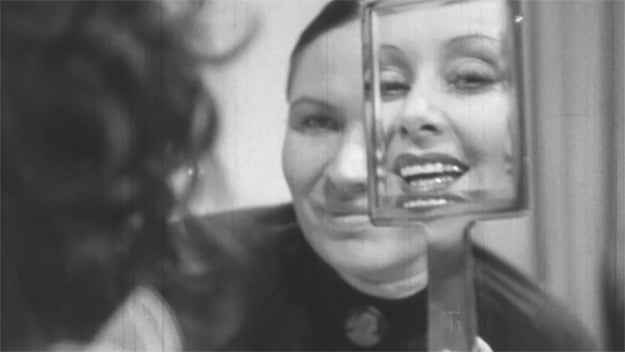Schlussakkord (Final Chord) (Douglas Sirk, 1936) Two days before this year’s Nitrate Picture Show, filmmaker Charlie Shackleton dropped by the Dryden Theatre—housed within the George Eastman House in Rochester, New York—as part of an international tour for his new essay film, The Afterlight. Composed entirely of movie fragments featuring actors and actresses who are no longer alive, The Afterlight exists only as a single, polyester-based 35mm print that progressively scratches, burns, or otherwise deteriorates with each screening—until it is no longer exhibitable, at which point, the film will cease to exist. “Any misgivings I might have had in seeing what’s become of the decades-old prints [at the George Eastman Museum], and imagining what might become of my own, are easily offset by that giddy feeling of collaboration—between filmmaker, exhibitor, and audience—and the singular experience it produces each time,” Shackleton told me. “The audience is tethered to a cultural object.” That spirit of communion is the raison d’être of the Nitrate Picture Show, which wrapped up its latest edition on June 5 at the Dryden. Every film exhibited in the four-day festival is a 35mm print with a volatile cellulose nitrate base, making for an even more ephemeral and unrepeatable experience than The Afterlight. Nitrate stock was an industry standard until the end of the 1940s, when it was phased out due to its tendency to self-combust as the chemicals that compose the film base decay. Nitrate was eventually replaced by acetate and polyester (or “safety”) film bases, but it still holds a mythic place in the cinephilic imagination, in no small part due to its scarcity and rapid, dangerous breakdown. While very few film vaults are equipped to maintain the proper temperature and humidity required for safe storage of nitrate, even fewer theaters are fitted with the fireproofing required to project these prints, making the Dryden an oasis of film exhibition for the purist filmgoer. Other than its rarity and combustibility, what makes nitrate special? The stock certainly has a unique look: it allows for vivid color contrast (the colors used in these prints often come from increasingly scarce Technicolor dye systems of the 1930s and 1940s), as well as sharp details in the darkest and lightest parts of the image. Also, the majority of the prints that screen at the Nitrate Picture Show are “first-generation” exhibition prints, meaning that they haven’t been duplicated or transferred to a less combustible polyester base, a process that causes loss in image definition. The theme of fatality, ever present at the festival, was never stronger than in this year’s presentation of Western Approaches, Pat Jackson’s 1944 Technicolor wartime propaganda piece shot by frequent Powell and Pressburger collaborator Jack Cardiff and produced by the British government’s General Post Office Film Unit—a relatively prolific producer of nitrate exhibition prints during World War II. The film depicts the passage of a supply caravan across the Atlantic Ocean and its pursuit by German U-boats. While most of the film was shot in England’s Pinewood Studios and on the Irish coast, it also features several documentary sequences of an actual convoy departing Manhattan. In the film, all of these ships survive their journey (if only barely), but in actuality, many sank before they reached British waters. Preserved in glorious Technicolor, the film’s grand sequences of military pomp feel laden with irony and dread when viewed today. This year’s festival also showed several short works by the avant-garde animator Len Lye that were released by the same subdivision of Britain’s postal service, including 1936’s Rainbow Dance and 1940’s Musical Poster No. 1. The former is an advertisement for opening a savings account at a bank, produced using a then-new, subtractive three-color process called “Gasparcolor,” whose cheery, vibrant hues make the animation pop. The latter is a public service announcement about remaining mum on Allied troop positions in communications, featuring swastikas dancing across the screen to drive home the message. This sort of colorful ephemera—early shorts, commercials, and camera tests—comprise some of the most memorable mainstays of the Nitrate Picture Show. Not every screening at the Dryden was plagued by the aura of decay. The most crowd-pleasing screenings were of relatively healthy nitrate prints of Ernst Lubitsch’s 1946 Cluny Brown (from UCLA’s archive) and Hitchcock’s 1948 Rope (from the Library of Congress), which exuded a sense of cinephilic euphoria as opposed to foreboding. At one screening, festival founder and former Eastman House curator Paolo Cherchi Usai described projecting Rope as an exercise in performance art: the cuts in the film’s “single-take” illusion are hidden in the reel changes, making the film’s haute tension conceit dependent on the expertise of the projectionists. Every film at the festival opened with acknowledgements and extended applause for the projectionists—Patrick Tiernan, Ben Tucker, Chris Crouse, Nicole Diroff, Florian Höhensteiger, and Sheryl Smith—toiling away in the fireproofed booth for our entertainment. The festival’s rarest and most meaningful screenings were a pair of underseen masterpieces from prolific auteurs: Douglas Sirk’s 1936 German-produced Schlussakkord (Final Chord), from the Eastman Museum’s collection, and Mikio Naruse’s 1951 Meshi (Repast), from the National Film Archive of Japan. Both prints seemed to be within a few torn perforations of ruin. The Sirk—which has predominantly circulated in 16mm exhibition prints—had required nearly 200 splices to make it projectable, while the Naruse significantly exceeded the commonly accepted percentage of shrinkage for exhibition. Both films were first-time watches for me, and the uneven textures of the prints engrossed and enthralled me, even when the projector dimmed and the image stopped for a brief moment on a dangerously shrunken stretch of Meshi. It was a reminder of what makes attending the Nitrate Picture Show a haunting experience unlike any other: you never know if you’ll be among the last audience ever to see a print on screen. Mackenzie Lukenbill is an audiovisual archivist and editor, and a Digital Archive Assistant at Film Comment.
